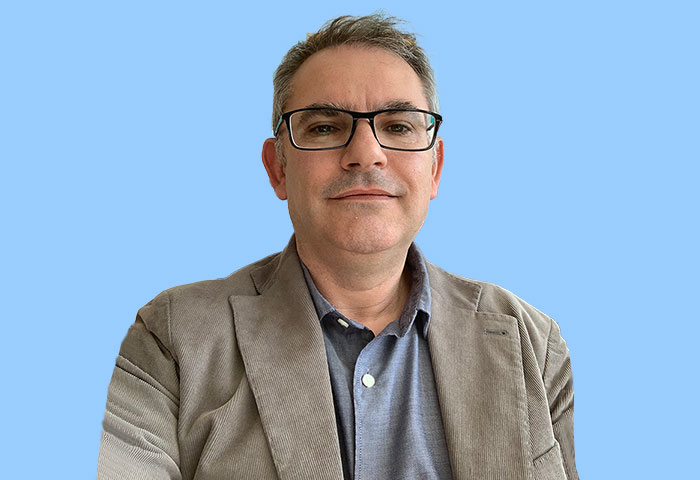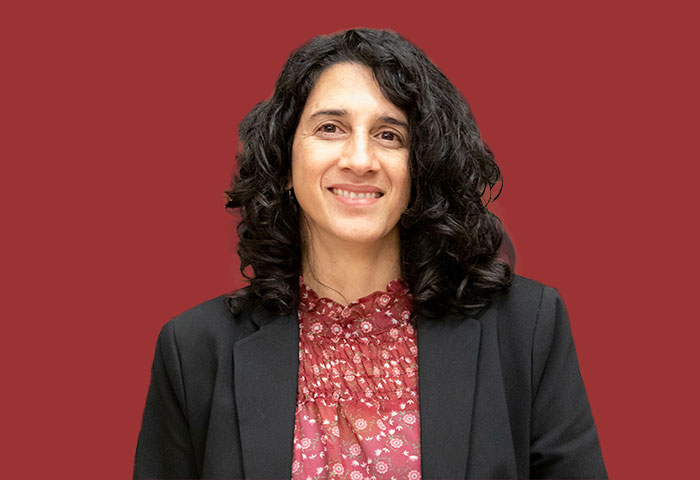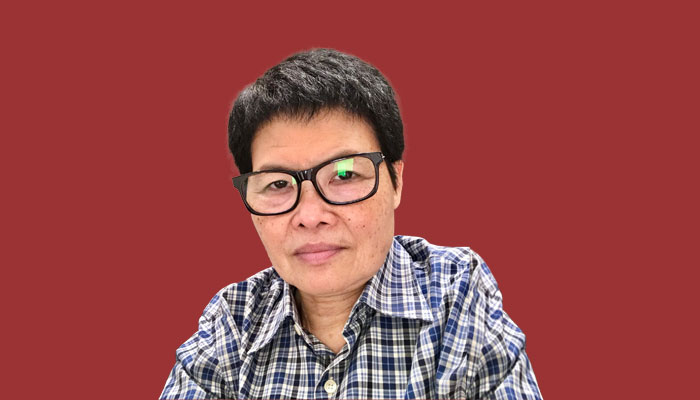Dignity, Freedom, and Justice for all is the theme for Human Rights Day 2022. For 75 years, these values have driven our work to ensure that workers are not stripped of their humanity through forced labor and that child labor does not deprive children of their innocence. It is challenging work, but staff implementing ILAB-funded projects make progress possible. They bring different skills and experience to their work, but they all share intense dedication and commitment to the mission. And that is how sustainable change happens. This year we're highlighting five staff who stand up for human rights every day to achieve a world free of child labor, forced labor, and human trafficking. We hope their words inspire you as much as their work inspires us.

Lorenzo Guarcello
Manager, Research to Action Project
International Labor Organization
What inspired you to work toward the elimination of child labor and forced labor?
Producing research informing the fight against human rights violations represents the best way of putting my knowledge to serve society. We support countries in data collection, research design, and knowledge production and sharing to expand the knowledge base to inform policy decisions and actions.
What motivates you to do this work? What do you find most rewarding?
Knowing that the knowledge you contributed to produce can be translated into a policy, a program, that can help those in need is highly satisfying. I find it most rewarding to work with governments, researchers, and other stakeholders to contribute to a better world.
What is your proudest accomplishment?
When you see the results of research being translated into actions. It has happened in many countries. Most recently, because of a study and efforts of the ILO country office, Vietnam revised its Law on Statistics to include regular reporting on child labor. This critical step shows the country's commitment to eradicating child labor by monitoring the issue regularly and formulating solutions.
In June 2022, through the Research to Action project, we created opportunities for early-career researchers to expand the evidence base to achieve policy impact in the fight against child labor, forced labor, and human trafficking. They shared their latest findings with researchers, policy actors, social partners, and practitioners worldwide. It represents a critical step in strengthening partnerships and exploring the logistics of refining evidence on effective solutions.
What advice would you give people starting to work in combating child and forced labor?
Do it with passion. Get to know the countries and their social and economic situations. Hear the stories of those living in vulnerable situations. Give a human face to the numbers. Keep pushing. Be open to collaborating with other partners and involve policy actors at every step of your research process. The results of your work can be immediate, or it can take years to be translated into action. But be reassured that your work will contribute to the fight against child labor, forced labor, and human trafficking. Keep in mind that together we can make a difference in someone's life.

Grace Banya
Project Director, CAPSA Project
International Labor Organization
What inspired you to work toward the elimination of child labor and forced labor?
The struggle against child labor is, first and foremost, a matter of changing attitudes and a matter of the heart. As a mother, I believe that all children should be protected and in school, not at work. Children should never be involved in hazardous work and deprived of their childhood. My inspiration to work towards eliminating child and forced labor is premised on my love for children. I take great pride in seeing children grow, thrive, and enjoy their childhood up to when they are old enough to determine their destinies.
What motivates you to do this work? What do you find most rewarding?
What I find most rewarding is when interventions to prevent child/forced labor are owned by communities and households, and their children can access quality education and thrive. This is because this approach is more sustainable. There are several things that are rewarding, but if I could pick another one, it is talking to a survivor of child/forced labor whose life has changed due to the work I and many other colleagues and partners do to make it possible for survivors to access quality services, access regular schooling, health care, training, counseling as well as a safe environment, legal aid and security.
What is your proudest accomplishment?
I am proud that the ideas I have initiated and translated into actionable interventions have achieved good results. One example is the recent child and forced labor training that I convened, targeting 17 police officers who oversee all the police posts in and around Nairobi. One of the Green Park station officers immediately applied the training knowledge and set up a special children's rescue room at the police post. He also negotiated with the Nairobi County government to get more space to accommodate additional children rescued from child and forced labor situations. He was recently given two buildings, which the county government has offered to renovate and upgrade into a model child protection unit (CPU). The CPU will be used as a central referral point that will service all of Nairobi's central business district, the hot spot for child and forced labor, trafficking, and many other vices that target children. It's my absolute pride to have positively influenced this officer and ignited a passion for helping children escape exploitation. He is our child and forced labor.
What advice would you give people starting to work in combating child and forced labor?
My advice to people starting work combating child and forced labor is to have a passion for their work! The job of tackling child and forced labor is a matter of the heart. Secondly, because the worst child labor abuses occur among the poorest and the most vulnerable groups in society, working on programs to improve access to education for these children needs to be accompanied by various incentives, including subsidies of various kinds, such as the provision of stipends, free meals at school, textbooks, health care or clothing for children as well as skills training and capacity strengthening for families to generate more income is critical.
It is also critically important to initiate programs that simultaneously address the need for improved policy and legal frameworks which guarantee the government's central role of ensuring universal compulsory education, universal social protection, nutrition, health care, skills training, and general protection of children's rights to safety are in place.
Other necessary preventive measures must be established to ensure that workplaces and industries are child and forced-labor-free. These monitoring systems are essential because the community's commitment to ensure their activities and workplaces are child and forced-labor-free is paramount.

Maró Guerrero
Director, PAR Project
Desarrollo y Autogestión
What inspired you to work toward the elimination of child labor and forced labor?
I grew up in a middle-class family in Ecuador. Class differences and my opportunity to go to school when other children my age could not always upset me. Early in my career, I met the organization Desarollo y Autogestión (DyA) while they were investigating child labor in gold mines and garbage dumps in Ecuador. The situation the children were living in, especially those who worked in the garbage dumps, made me angry, it hurt me. I can't erase from my mind images like babies sleeping in garbage boxes or children eating rotten fruit that fell from garbage trucks. That injustice moved me to decide that I wanted to contribute to change things. I was also inspired by the strength of women's organizations that fight for the betterment of their communities, despite having nothing and living in impoverished communities. They continue to inspire me when I think the world is wrong and difficult to change.
What motivates you to do this work? What do you find most rewarding?
The small changes and personal stories are the most rewarding for me. The day a teenager who wasn't in school graduates. The day a girl says she stopped working and likes the activities that school offers her. When a mom says her son's dreams of going to college have come true. It motivates me when community organizations empower themselves and generate and sustain initiatives. When a public official decides to go beyond what the manual says, takes risks and develops new public policy. That's when I think we've put our efforts in the right place.
What is your proudest accomplishment?
In Argentina, one of the greatest achievements has been the implementation of a Social Compliance System for the prevention of child labor in blueberry production that we designed from scratch, tailored to the production chain. Blueberry producers now train their workers on child labor, develop awareness campaigns, and have a monitoring system and an app they use during the harvest. They also now have action protocols to follow if a child labor case appears. Most importantly, the compliance system has leveraged local resources and allowed producers to reach agreements with government agencies to implement new educational services for youth in their communities.
What advice would you give people starting to work in combating child and forced labor?
First, it is essential to investigate, understand reality, listen to the people involved in the problem, and build solutions together because the problem is complex and very large. It is essential to go further and work with employers, with universities and promote discussion in new professional fields that may not be aware of the issue.

Wendy Orellana
Technical Assistant, Futuros Brillantes Project
World Vision
What inspired you to work toward the elimination of child labor and forced labor?
As a child, I remember observing children working on coffee farms in my hometown of Arada, Santa Barbara, located in western Honduras. At a young age, I didn't know what that really meant. But child labor is an alarming scourge that affects hundreds of thousands of children in my country, a day-to-day reality, but also invisible.
Knowing about this social issue and being aware of its true meaning, I found admiration and inspiration in the resilience, effort, dreams, and joy that working children possess despite their adversities and lack of opportunity. That they fight every day to have better economic conditions is admirable. As a citizen and agent of change dedicated to the development of my country, I have sought to work with others to change the child labor situation, to create a better future for families and future generations.
What motivates you to do this work? What do you find most rewarding?
I find great motivation in knowing that my work can change how people think and behave, positively impacting their personal and family lives. Since childhood, I've enjoyed helping and serving others. As a psychologist, I have had the opportunity to use that passion and commitment to fight for children and their families, looking for new opportunities to improve their quality of life.
The greatest gratification is being part of that transformative change and working with community groups in different areas of the country, such as the local committees against child labor. They volunteer their talents, knowledge, and time to advocate for children's rights and generate social change to eliminate child labor. Each one is an example of leadership and passion.
What is your proudest accomplishment?
As a woman, personally and professionally, I am proud to have the opportunity to empower and strengthen the skills of the women who are part of the local committees against child labor in different areas of the country. Currently, more than 70 percent of the members of the committees are women, and they play an important role in advocacy and social mobilization in their communities. They are leaders who belong to local governance spaces and influence action to prevent child labor.
What advice would you give people starting to work in combating child and forced labor?
Fighting child labor is not easy; therefore, working in a coordinated manner with strategic allies from the government to the communities where child labor is happening is essential. The sum of this work will lead to the decisions and actions carried out being more sustainable and having a greater impact on reducing child labor.

Nguyen Mai Oanh
National Project Manager, ENHANCE Project
International Labor Organization
What inspired you to work toward the elimination of child labor and forced labor?
I strongly believe that children are among the most vulnerable groups in society, who need special protection to ensure their rights are fully respected, and they are treated equally. Based on this belief, I have devoted more than 20 years of my career to eliminating child labor and forced labor.
What motivates you to do this work? What do you find most rewarding?
I know that as an individual, I alone cannot improve the situation of the children in my country, yet I know that I am not alone in this noble mission. Gradual improvements, outputs, and achievements have built up over time due to the wonderful efforts of my team, ILO, and partners, which really motivate me to keep going. Thanks to these joint efforts, I have witnessed the enhanced capacity of our partners and stakeholders. This is visible in the significant progress in awareness raising and partnership building at different levels of society when local partners at the provincial level strive to work alongside my team to support thousands of children. When you see the smiles on the faces of these children enjoying their well-deserved benefits and rights. All of this motivates me to do this work, and I find all of these moments rewarding.
What is your proudest accomplishment?
I should say that I, along with the ENHANCE team, the ILO, and our partners, am proud of each accomplishment that we have achieved with the support of USDOL. Every accomplishment, big and small, contributes to this long-term mission.
The efforts of the ENHANCE project have led to significant progress in terms of awareness raising and partnership building at different levels of society in Viet Nam. The project has promoted increasingly open dialogue related to child labor, especially among policymakers and the media, to enhance awareness and contribute to changing attitudes and practices among key target groups and the public. ENHANCE implemented a comprehensive communication strategy using traditional and non-traditional methods and channels to achieve this. These efforts have mobilized multiple new stakeholders and partners to work together to address child labor in Viet Nam.
What advice would you give people starting to work in combating child and forced labor?
As previously mentioned, combating child labor and forced labor is a long-term and difficult mission; it requires more than the motivation of one individual to improve the lives of children and uphold their legal rights. The work itself depends on collaborative, hands-on actions and efforts, not just from yourself as an individual but also from your team, direct stakeholders, political leaders, and the whole of society. The understanding and commitment of donors are also crucial.
